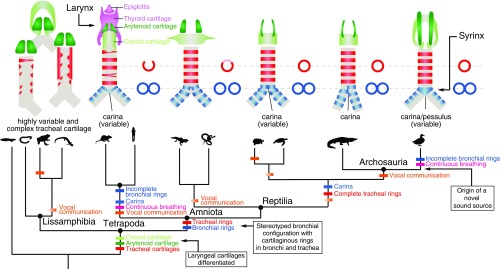Fig. 1.
Tetrapod phylogeny showing the sequence of the acquisition of different airway traits through evolutionary time. (Upper, Left to Right) Schematic diagrams depict airway morphology in caecilians, frog, salamander, rat, gecko, tortoise, alligator, and a duck. Paired arytenoid cartilages (dark green) are present in most tetrapods (26). Cricoid cartilage (light green) is absent in some lissamphibians. Tracheal cartilage morphologies (red) are highly irregular (i.e., not ring-shaped) in lissamphibians (29), and irregular, forked rings are also sometimes observed in mammals (88). Stereotyped configuration of trachea and paired bronchi is common to all amniotes, and cartilaginous rings are observed in both the bronchi and trachea (49). Fusion of bronchial rings (blue) at the tracheobronchial juncture forms a carina, or a pessulus in birds (26). (Lower) Colored dashes indicate the branches along which distinct morphological and behavioral innovations (15, 61) may have evolved, with uncertainty (i.e., variability among species in a group) indicated by color gradients. Boxes describe major transitions leading to a syrinx in modern birds.

